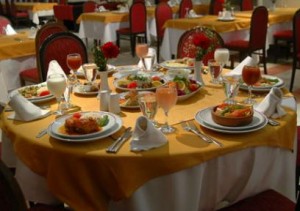BASIC STRUCTURE OF TURKISH CUISINE
Asurvey of the types of dishes according to their ingredients may be helpful to explain the basic structure of Turkish Cuisine.Otherwise there may appear to be an overwhelming variety of dishes, each with a unique combination of ingredients and its own way of preparation and presentation. All dishes can be conveniently categorized into grain-based, grilled meats, vegetables, seafood, desserts and beverages.
Before describing each of these categories, some general comments are necessary. The foundation of the cuisine is based, on grains (rice and wheat) and vegetables. Each category of dishes contains only one or two types of main ingredients. Turks are purists in their culinary taste, that is, the dishes are supposed to bring out the flavor of the main ingredient rather than hiding it under sauces or spices. Thus, the eggplant should taste like eggplant, lamb like lamb, pumpkin like pumpkin, and so on. Contrary to the prevalent Western impression of Turkish food, spices and herbs are used very simply and sparingly For example, either mint or dill weed are used with zucchini, parsley is used with eggplant, a few cloves of garlic has its place in some cold vegetable dishes, and cumin is sprinkled over red lentil soup or mixed in ground meat when making ?kofte? (meat balls). Lemon and yogurt are used to complement both meat and vegetable dishes as well as to balance the taste of olive oil or meat. Most desserts and fruit dishes do not call for any spices. So their flavors are refined and subtle.
There are major classes of meatless dishes. When meat is used, it is used sparingly Even with the meat kebabs, the ?pide? or the flat bread is the largest part of the dish alongside vegetables or yogurt. Turkish cuisine also boasts a variety of authentic contributions to desserts and beverages.
 For the Turks, the setting is as important as the food itself. Therefore, food-related places need to be considered, as well as the dining protocol. Among the great food places where you can find ingredients for the cuisine are the weekly neighborhood markets (?pazar?) and the permanent markets. The most famous one of the latter type is the Spice Market in Istanbul. This is a place where every conceivable type of food item can be found, as it has been since pre-Ottoman times. This is a truly exotic place, with hundreds of scents rising from stalls located within an ancient domed building, which was the terminus for the Spice Road. More modest markets can be found in every city center, with permanent stalls for fish and vegetables.
For the Turks, the setting is as important as the food itself. Therefore, food-related places need to be considered, as well as the dining protocol. Among the great food places where you can find ingredients for the cuisine are the weekly neighborhood markets (?pazar?) and the permanent markets. The most famous one of the latter type is the Spice Market in Istanbul. This is a place where every conceivable type of food item can be found, as it has been since pre-Ottoman times. This is a truly exotic place, with hundreds of scents rising from stalls located within an ancient domed building, which was the terminus for the Spice Road. More modest markets can be found in every city center, with permanent stalls for fish and vegetables.
The weekly markets are where sleepy neighborhoods come to life, with the villagers setting up their stalls before dawn in a designated area to sell their products. On these days, handicrafts, textiles, glassware and other household items are also among the displays at the most affordable prices. What makes these places unique is the cacophony of sounds, sights, smells and activity, as well as the high quality of fresh food, which can only be obtained at the pazar. There is plenty of haggling and jostling as people make their way through the narrow isles while vendors compete for their attention. One way to purify body and soul would be to rent an inexpensive flat by the seaside for a month every year and live on fresh fruit and vegetables from the pazar. However, since the more likely scenario is restaurant-hopping, here are some tips to learn the proper terminology so that you can navigate through the cuisine (just in case you get the urge to cook a la Turca) as well as the streets of Turkish cities, where it is just as important to locate the eating places as it is the museums and the archeological wonders.
- Genel
- Yorumlar(0)
